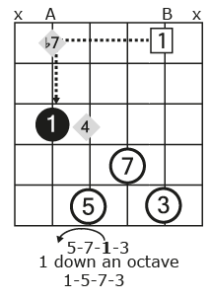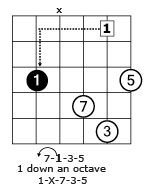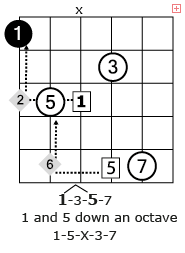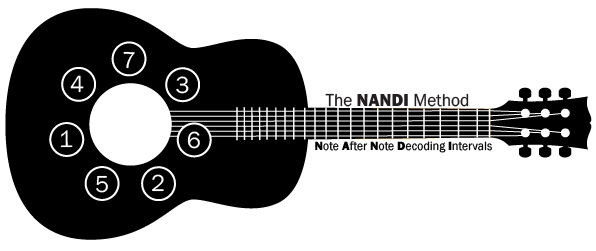Seventh Chords are the chords produced if you stack an additional third on top of a basic triad. They are so named because one third above the 5 is the seventh. Seventh chords are especially interesting because of the large variation in the qualities they have and their functions.
Look at the table below to see the various qualities of seventh chords:
Seventh Chords
Quality Triad Intervals Root C
Major 7th Major (1-3-5) 1 - 3 - 5 - 7 C-E-G-B
Dominant 7th Major (1-3-5) 1 - 3 - 5 - ♭7 C-E-G-B♭
Minor 7th Minor (1-♭3-5) 1- ♭3 - 5 -♭7 C-E♭-G-B♭
Min-Maj 7th Minor (1-♭3-5) 1 - ♭3 - 5 - 7 C-E♭-G-B
Half-Dim 7th Diminished (1-♭3-♭5) 1 - ♭3 - ♭5 - ♭7 C-E♭-G♭-B♭
Dim 7th Diminished (1-♭3-♭5) 1-♭3-♭5-𝄫7 C-E♭-G♭-B𝄫
Maj 7th(#5) Augmented (1-3-#5) 1-3-#5-7 C-E-G#-B
Dominant 7th (#5) Augmented (1-3-#5) 1-3-#5-♭7 C-E-G#-B♭
We should note that a diminished seventh chord is one of the few times you will see a double-flat (♭♭). Think of it like this. If a minor third from a 5 is a ♭7, then a minor third from a ♭5 is a ♭♭7. The ♭♭7 is enharmonic to a 6.

Major Seventh Drop 2 Voicing
Chords can be played in either open or closed voicings. A closed voicing is when all of the notes being played are within the span of one octave. An open voicing is when the notes being played span more than an octave. You can achieve an open or “spread” voicing by taking the 2nd voice (2nd highest note) or a chord in closed position and drop it down an octave. This would be called “Drop 2” voicing. For example, if we have a Cmaj7 voiced 5-7-1-3 (G-B-C-E), then the 2nd highest voice is C. When we drop the C an octave, it becomes the bass note, and the voicing changes to 1-5-7-3.

Drop 2 Chords in C major
Major Seventh Drop 3 Voicing
When the 3rd highest note in a close position chord is dropped down an octave, you get a drop 3 voicing. For example, when C which is the third highest note from the top in a C Major Seventh close position chord (B-C-E-G) is dropped down an octave so that it becomes the bass note, a drop 3 voicing is created: C-x-B-E-G (1-x-7-3-5).

Major Seventh Drop 2 & 4 Voicing
When you drop the second and fourth highest notes from a closed position chord down an octave, the result is a drop 2 & 4 voicing. In a root position C major seventh chord (C-E-G-B), G and C are the second and fourth highest notes from the top. When those notes are dropped down an octave, the result is a drop 2 & 4 voicing: C-G-x-E-B (1-5-x-3-7).

